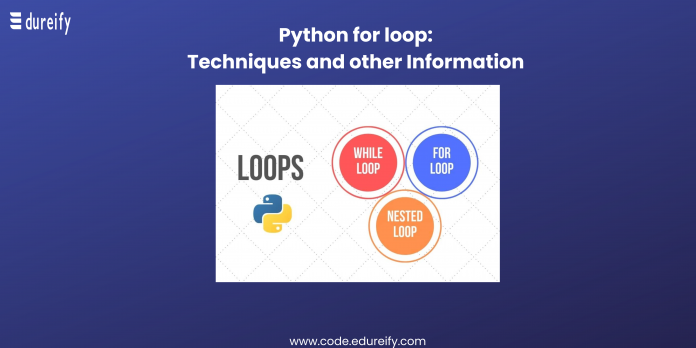Python is a high-level programming language that is an interpreted and object-oriented computer language. Python is used as a scripting or glue language to connect existing components. It is also very attractive for Rapid Application Development for its high-built data structures feature combined with dynamic typing and dynamic binding.
Edureify, the best AI Learning App has earlier talked about the Top 10 Python Courses to Take Up in 2022. In this article, we will talk about Python for Loop, a feature that works like an iterator method that is found in other object-oriented programming languages.
Read on to know about Python for Loop.
What is Python for Loop?
Python programming’s fundamental looping statement is the Python for Loop. Python uses its ‘for loop’ to iterate over a sequence which could be a tuple, string, list, or array.
The ‘for loop’ is used for sequential traversal. This feature is similar to the ‘for each’ loop in other programming languages.
How to create a ‘for loop’?
Creating a Python for loop is very easy. To explain it very simply, the following two steps can be followed to create a ‘for loop’-
- First, one needs to define the iterable object they would like to loop through
- Now, define the actions one would like to perform on each item in that iterable object
Some Useful Techniques of ‘for loop’
Following are some useful techniques of ‘for loop’ that help in the programming applications-
1. Break Statement in ‘for loop’-
To exit from a loop immediately after the condition is met, the Python break statement is used.
2. Continue Statement in ‘for loop’-
To skip the current iteration of a loop and continue with the next one, the Python continue statement is used.
3. Range () Function-
To iterate through each number in a specified range, the Python range () function is used. This function executes a group of statements for a specified number of times.
4. Else in ‘for loop’-
At the end of a ‘for loop’, Python enables the else clause. This statement is executed when the loop has exhausted iterating the list or set.
5. Access Index-
The enumerate () function is used to iterate the indices in a sequence.
6. Pass Statement-
‘For loops’ cannot be empty. In case the ‘for loop’ is placed with no content, use the pass statement to avoid getting an error.
7. Zip () Function-
The zip () function is used to loop through multiple lists at once.
Nested Loops
When there is a loop inside a loop it is called a nested loop. For every iteration of the outer loop, the inner loop will be performed once.
Note– Too many levels of nesting can make it difficult to follow the program. One must restrict to not using more than three levels of indention.
Python While Loop
To execute a block of statements repeatedly until a given condition is satisfied, the Python While Loop is used. The while loop comes under the category of indefinite iteration. Once the condition becomes false, the line immediately after the loop in the program is executed.
Here was the fundamental looping statement of Python, Python for Loop and its various syntax statements. Edureify also has other programming articles like JavaScript, SQL, Node.js, Blockchain technology, and more to help students learn about the different technologies that go into web development. Students can also check out our Learn Coding site to take up any course of their choice to learn about the technologies and software.
Some FAQs on Python for Loop-
1. What is Python?
Python is a high-level programming language that is an interpreted and object-oriented computer language. Python is used as a scripting or glue language to connect existing components. It is also very attractive for Rapid Application Development for its high-built data structures feature combined with dynamic typing and dynamic binding.
2. What is the function of Python for loop?
The Python for loop is a fundamental looping statement that is used to iterate over a sequence which could be a tuple, string, list, or array.
3. Mention some of the techniques used in Python for loop.
To name some of the techniques used in Python for loop are-
- Break statement
- Continue statement
- Range Function
- Else Function
- Pass Statement
- Zip Function
- Access Index
4. What is Nested Loop?
When there is a loop inside a loop it is called a nested loop. For every iteration of the outer loop, the inner loop will be performed once.
5. Where can I get more informative articles on Python?
Edureify has all the important informative articles on Python. Students can read more on the Edureify website.
Master Your Coding Skills with BootSelf AI
If you're looking to enhance your coding abilities and upskill in artificial intelligence, look no further than the BootSelf AI app. This innovative platform provides AI-based coding lessons that are tailored to your individual learning pace.
Available on both iOS and Android, you can download the BootSelf AI app and start mastering coding skills today:











